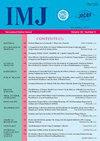ROLE OF ULTRASONOGRAPHY IN DIAGNOSIS OF SPINAL STENOSIS WITH LUMBAR OSTEOCHONDROSIS
Q4 Medicine
引用次数: 0
Abstract
Diagnostic visual examinations for patients with any type of spinal stenosis include either magnetic resonance imaging or computed tomography with myelogram, sometimes both tests are prescribed to patients. Ultrasound is usually most effective for tissues with a high content of collagen, i.e. tendons, ligaments, joint capsules and fascia. In osteochondrosis, spinal ultrasonography is used to determine whether a back pain is the result of cracks or a herniated disc. To evaluate the possibilities of ultrasound in diagnosis of lumbar spine stenosis, an analysis of its results in 48 patients aged 41−57 years. Forty five of them were diagnosed with intervertebral disc herniation, 3 with protrusion of various localization and hypertrophy of the yellow ligament. All the patients underwent radiography, magnetic resonance or computed tomography, as well as ultrasound. In 24 patients the laminectomy was performed in 31 discs. In 21 cases, the hernia was paramedian, in 17 it was − median and in 14 this was circular. Laminectomies were performed much more frequently due to median and circular hernias. The slightest deformation of spinal canal is observed in the posterolateral localization of hernia or protrusion. In thin individuals, ultrasound images of the spinal canal elements were excellent, in those with moderate weight they were slightly inferior to magnetic resonance imaging. In three cases of spinal canal stenosis in obese patients who underwent laminectomy, the results of ultrasonography were unsatisfactory and the decision for surgery was made only on the basis of magnetic resonance imaging. It is concluded that ultrasound is a very informative way of assessing the degree of lumbar spine stenosis resulted from degenerative changes in intervertebral discs. Key words: ultrasonography, spinal canal stenosis, lumbar osteochondrosis, lumbar intervertebral discs.超声在腰椎管狭窄合并腰椎软骨疏松症诊断中的作用
任何类型的椎管狭窄患者的诊断性视觉检查包括磁共振成像或骨髓图计算机断层扫描,有时这两种检查都是给患者开的。超声波通常对胶原蛋白含量高的组织最有效,即肌腱、韧带、关节囊和筋膜。在骨软骨病中,脊椎超声检查用于确定背痛是由骨折还是椎间盘突出引起的。为了评估超声诊断腰椎管狭窄症的可能性,对48名年龄在41-57岁的患者的结果进行分析。其中45例诊断为椎间盘突出,3例诊断为不同部位的椎间盘突出和黄韧带肥大。所有患者均接受了放射照相术、磁共振或计算机断层扫描以及超声检查。在24例患者中,对31个椎间盘进行了椎板切除术。21例为正中旁疝,17例为正中疝,14例为环形疝。由于正中疝和环形疝,椎板切除术的频率要高得多。在疝或突出物的后外侧定位中可以观察到椎管的最轻微变形。在瘦子中,椎管元件的超声图像非常好,在中等体重的人中,它们略低于磁共振成像。在三例接受椎板切除术的肥胖患者的椎管狭窄病例中,超声检查结果不令人满意,仅根据磁共振成像决定手术。结论是,超声是评估椎间盘退行性变化引起的腰椎狭窄程度的一种非常有信息的方法。关键词:超声检查,椎管狭窄,腰椎骨软骨病,腰椎间盘。
本文章由计算机程序翻译,如有差异,请以英文原文为准。
求助全文
约1分钟内获得全文
求助全文
来源期刊

International Medical Journal
医学-医学:内科
自引率
0.00%
发文量
21
审稿时长
4-8 weeks
期刊介绍:
The International Medical Journal is intended to provide a multidisciplinary forum for the exchange of ideas and information among professionals concerned with medicine and related disciplines in the world. It is recognized that many other disciplines have an important contribution to make in furthering knowledge of the physical life and mental life and the Editors welcome relevant contributions from them.
The Editors and Publishers wish to encourage a dialogue among the experts from different countries whose diverse cultures afford interesting and challenging alternatives to existing theories and practices. Priority will therefore be given to articles which are oriented to an international perspective. The journal will publish reviews of high quality on contemporary issues, significant clinical studies, and conceptual contributions, as well as serve in the rapid dissemination of important and relevant research findings.
The International Medical Journal (IMJ) was first established in 1994.
 求助内容:
求助内容: 应助结果提醒方式:
应助结果提醒方式:


